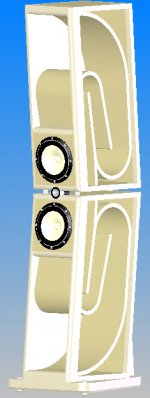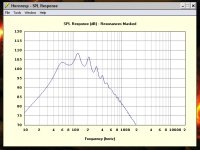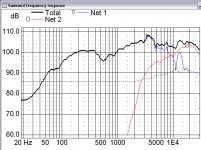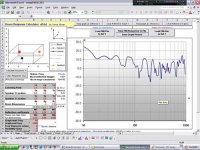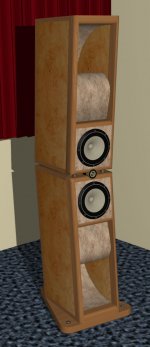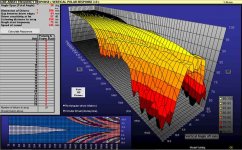Hello everyone,
I've been throwing some ideas around again today after being inspired by some Cain & Cains last night. This is what I've come up with so far anyway, using Fostex FE208EZ drivers run fullrange and a T90A supertweeter. I've developed the horns in hornresp and they seem to be fine, assuming I haven't overlooked anything. Any comments/suggestions/problems you can see would be really appreciated.
Thanks all,
Steve
I've been throwing some ideas around again today after being inspired by some Cain & Cains last night. This is what I've come up with so far anyway, using Fostex FE208EZ drivers run fullrange and a T90A supertweeter. I've developed the horns in hornresp and they seem to be fine, assuming I haven't overlooked anything. Any comments/suggestions/problems you can see would be really appreciated.
Thanks all,
Steve
Attachments
Hi,
Well this is what hornresp tells me, for a single horn. So I guess add 3dB to everything for the double horns in parallel. I'm fairly sure that that graph represents what would happen if the speaker was right in the corner of a room, so I'll probably end up taking in room measurements when they're built to position them well. As far as direct radiation from the drivers goes, the FE208EZ's are rated at 97dB each, so I'm aiming at an overall sensitivity of around 100dB. Hopefully any baffle step problems (if it is a problem with horns?) can be solved by careful room placement. As to outright max nice sounding SPL, enough I hope!
Thanks,
Steve
Well this is what hornresp tells me, for a single horn. So I guess add 3dB to everything for the double horns in parallel. I'm fairly sure that that graph represents what would happen if the speaker was right in the corner of a room, so I'll probably end up taking in room measurements when they're built to position them well. As far as direct radiation from the drivers goes, the FE208EZ's are rated at 97dB each, so I'm aiming at an overall sensitivity of around 100dB. Hopefully any baffle step problems (if it is a problem with horns?) can be solved by careful room placement. As to outright max nice sounding SPL, enough I hope!
Thanks,
Steve
Beautiful!
The only concern I would have is lobing caused by having all three drivers running to very high frequencies (10k +) and with relatively large center to cnter spacing. The general rule of thumb is that MTMs should be crossed over at a frequency whose wavelength ~= the mid to tweeter spacing.
The only concern I would have is lobing caused by having all three drivers running to very high frequencies (10k +) and with relatively large center to cnter spacing. The general rule of thumb is that MTMs should be crossed over at a frequency whose wavelength ~= the mid to tweeter spacing.
Cheers Henry, I did wonder about that, but I read some reviews on the Seventh Veils and they just said it lacked treble if you're stood up, but are fine when you're sat down with your head at the correct level. in my design the tweeter is bang on head height (1m) and the mids point inwards so they converge 2m away from the speaker, though im not sure if that helps. If it does turn out to be a big problem the top box is identical to the bottom one, so I could just take the tops off and use them for rears for SACD in the future...
I've attatched a response curve for all drivers with a 1uF cap on the tweeter and 2 fostex's run full range. (this doesn't include the horn response so ignore the low frequencies) though I don't know if this will help sort out the lobing issue. Tweeter to mid distance is 163mm btw, which would mean approximately 2000kHz? (344 divided by 0.163). But then if lobing isn't a problem if your heads on the 'centerline' im not too worried.
Thanks again,
Steve
I've attatched a response curve for all drivers with a 1uF cap on the tweeter and 2 fostex's run full range. (this doesn't include the horn response so ignore the low frequencies) though I don't know if this will help sort out the lobing issue. Tweeter to mid distance is 163mm btw, which would mean approximately 2000kHz? (344 divided by 0.163). But then if lobing isn't a problem if your heads on the 'centerline' im not too worried.
Thanks again,
Steve
Attachments
Awesome!! or should I say intimidating 
I've been lookin into these full range drivers, there not exactly the last word in high frequency extension when compared to lowthers or the SV's little bandors. Somethin like 14K role off, so if that’s the case HF lobing may not be much of an issue if at all.
SolidWorks Student Edition? that blue background is such a give away
Hesky
I've been lookin into these full range drivers, there not exactly the last word in high frequency extension when compared to lowthers or the SV's little bandors. Somethin like 14K role off, so if that’s the case HF lobing may not be much of an issue if at all.
SolidWorks Student Edition? that blue background is such a give away
Hesky
Re. mid to tweeter spacing
Hi Steve
Enjoy,
Deon
Hi Steve
How about solving two problems with one go. How about dipping the upper driver with 3dB - 6dB obove the baffle-step. That will solve any problems with lobing and such due to the large spacing relative to XO frequency. The overall efficiency will still be very high.Hopefully any baffle step problems (if it is a problem with horns?) can be solved by careful room placement.
Enjoy,
Deon
Re: Re. mid to tweeter spacing
You could accomplish the same thing by just rotating the top horn so the driver faces backwards too.
dave
DeonC said:How about solving two problems with one go. How about dipping the upper driver with 3dB - 6dB obove the baffle-step. That will solve any problems with lobing and such due to the large spacing relative to XO frequency. The overall efficiency will still be very high.
You could accomplish the same thing by just rotating the top horn so the driver faces backwards too.
dave
MTM?
Why do you want to use the MTM arrangement?
Lots more box volume for little benefit.
It is my understanding you can get most of the imaging benefits of the MTM if you place the tweeter below the woofer.
It is caused by the non symetrical lobing which is better on one side i believe.
Coolin
Why do you want to use the MTM arrangement?
Lots more box volume for little benefit.
It is my understanding you can get most of the imaging benefits of the MTM if you place the tweeter below the woofer.
It is caused by the non symetrical lobing which is better on one side i believe.
Coolin
Re: Re. mid to tweeter spacing
Thanks for all the replies chaps!!
Wouldn't having a baffle step correction network put the top driver a little out of phase with the bottom? or would the effect be negligable... It kinda takes away from the whole D'Apolito symmetry thing too, though it's something I might try when they're built thanks.
Dave,
I was a bit worried about the fluctuations in response too. I modelled several 'comercialish' horn designs and found they all had a similar problem. What really stopped me worrying was this room simulation (see pic below) though I agree that's no excuse not to aim for a nice flat response, I'll probably tinker with the horn lots yet to try and optimise it a bit more, thanks.
Coolin,
Sensitivity and soundstaging, though this may not work out the same with full range 'mids'. From what Ive read the mid frequencies 'shroud' the tweeter output, reducing the chances of high frequencies being reflected off the roof/cieling. As far as I can imagine this in my head at the moment, this design should only create lobing effects in the vertical direction, not horizontal? So hopefully soundstaging should be unnefected? And the Seventh Veils I think suffer a similar problem, as far as I know have no problem at all creating a good soundstage.
Thanks again for all your replies!
Steve
Thanks for all the replies chaps!!
DeonC said:How about solving two problems with one go. How about dipping the upper driver with 3dB - 6dB obove the baffle-step. That will solve any problems with lobing and such due to the large spacing relative to XO frequency. The overall efficiency will still be very high.
Wouldn't having a baffle step correction network put the top driver a little out of phase with the bottom? or would the effect be negligable... It kinda takes away from the whole D'Apolito symmetry thing too, though it's something I might try when they're built thanks.
Dave,
I was a bit worried about the fluctuations in response too. I modelled several 'comercialish' horn designs and found they all had a similar problem. What really stopped me worrying was this room simulation (see pic below) though I agree that's no excuse not to aim for a nice flat response, I'll probably tinker with the horn lots yet to try and optimise it a bit more, thanks.
Coolin,
Sensitivity and soundstaging, though this may not work out the same with full range 'mids'. From what Ive read the mid frequencies 'shroud' the tweeter output, reducing the chances of high frequencies being reflected off the roof/cieling. As far as I can imagine this in my head at the moment, this design should only create lobing effects in the vertical direction, not horizontal? So hopefully soundstaging should be unnefected? And the Seventh Veils I think suffer a similar problem, as far as I know have no problem at all creating a good soundstage.
Thanks again for all your replies!
Steve
Attachments
The comment regarding the seventh veils having narrow vertical HF dispersion has more to do with the fact that it is a line array (albeit a pretty short one) rather than lobing from multiple drivers. The Seventh Veils uses closely spaced 3" drivers so the ~ 3" center to center spacing is not a lobing issue until higher up in the frequency range, about 4500 hz (if my math is correct).
Lobing does not directly cause limited vertical dispersion. The symptom of lobing is you will have one frequency response exactly on axis (your simulation shows only the on axis response) but moving your head up or down a few inches will cause a set of frequencies to have big nulls. Then moving your head a few more inches will cause different frequencies to have big nulls.
You are going to have center to center spacing between one "mid" and the tweeter of ~ 6 inches, so you will get lobing caused by interference patterns above ~ 2300 hz. Your tweeter will come in higher than that but you will get lobing effects for the range in which your tweeter response overlaps your mid response.
Even worse, is that for most of the refrequency range you are going to have the two Fostex drivers interfering with each other. These have a center to center spacing of ~10 inches. This will cause lobing starting at ~ 1200 hz.
The ironic part is that MTM actuall depend on controlled lobes to get a relatively narrow vertical dispersion (compared to TMs). The configuration is such that the two mids interfer but only enough to cause a single large lobe aimed at the listener . The nulls are above and below and help to reduce floor and ceiling reflections. At the higher frequencies the tweeter starts to beam which also limits dispersion. MTMs depend on close center to center spacing, a relatively narrow overlap between the mids and tweeter, and a moderate crossover frequency to minimize negative lobing effects.
Lobing does not directly cause limited vertical dispersion. The symptom of lobing is you will have one frequency response exactly on axis (your simulation shows only the on axis response) but moving your head up or down a few inches will cause a set of frequencies to have big nulls. Then moving your head a few more inches will cause different frequencies to have big nulls.
You are going to have center to center spacing between one "mid" and the tweeter of ~ 6 inches, so you will get lobing caused by interference patterns above ~ 2300 hz. Your tweeter will come in higher than that but you will get lobing effects for the range in which your tweeter response overlaps your mid response.
Even worse, is that for most of the refrequency range you are going to have the two Fostex drivers interfering with each other. These have a center to center spacing of ~10 inches. This will cause lobing starting at ~ 1200 hz.
The ironic part is that MTM actuall depend on controlled lobes to get a relatively narrow vertical dispersion (compared to TMs). The configuration is such that the two mids interfer but only enough to cause a single large lobe aimed at the listener . The nulls are above and below and help to reduce floor and ceiling reflections. At the higher frequencies the tweeter starts to beam which also limits dispersion. MTMs depend on close center to center spacing, a relatively narrow overlap between the mids and tweeter, and a moderate crossover frequency to minimize negative lobing effects.
Hmmm sounds like I will have to rethink a few things then. Do you think adjusting the angle of the drivers will change the lobing effect (theyre +-5deg at the moment) and are there any simultaion programs for that kind of thing? Or some maths and formulae...
One thing that bothers me a bit though, isn't the whole stereo pair thing fundamentally flawed in that you (theoretically in my head anyway) get lots of horizontal lobing starting at very low frequencies?
I got bored again this morning and did a few renders of the speakers, hehe....
One thing that bothers me a bit though, isn't the whole stereo pair thing fundamentally flawed in that you (theoretically in my head anyway) get lots of horizontal lobing starting at very low frequencies?
I got bored again this morning and did a few renders of the speakers, hehe....
Attachments
lobing solved, or partly understood...
Hello, I think I found what I was looking for as far as lobing simulations go, and this is what it threw up.... as far as I can tell response will stay within 3dB or so limits as long as keep my head within +-2ft of the centerline? To me that sounds acceptable, assuming the simulation is accurate and ive set it up correctly....
Steve
Hello, I think I found what I was looking for as far as lobing simulations go, and this is what it threw up.... as far as I can tell response will stay within 3dB or so limits as long as keep my head within +-2ft of the centerline? To me that sounds acceptable, assuming the simulation is accurate and ive set it up correctly....

Steve
Attachments
Two speakers would cause lobing effect if you were listening to mono and try to reproduce the exact same sound from two different locations which cause two different path lengths to your ears.
I don't think adjusting the angle will fix it. The angle can be used two aim the sweet spot to a very small area but as soon as you start to get the same sound played from two different locations you will get cancellation/lobing when the path to your ear from each source is a different length. For example; if you assume you are sitting exactly on the tweeter axis (assume one speaker for now) the path length from the top driver to your ears is, say, 10 feet. The path lengths from your ears to the bottom speakers is also 10 ft meters. Now you move your head so it directly aligned with the center of the top speaker. The distance from your ears to the top speaker is a little closer, say 9.9 feet. Your ears are a little further from the bottom speaker say, 10.1 feet. The difference in path lengths is .2 feet. That is the half wavelength of ~2.5 k hz. Playing a 2.5k tone will cause the sound from the two drivers to reach your ears exactly 180degrees out of phase and they will cancel.
I'm not familiar with the spread sheet you are using. If it allows you to place the three drivers at different positions (i.e. height) along the speaker baffle and if it uses this information to calculate the response you should be able to see the lobing by running multiple response plots and vary the listener's height with each one
I don't think adjusting the angle will fix it. The angle can be used two aim the sweet spot to a very small area but as soon as you start to get the same sound played from two different locations you will get cancellation/lobing when the path to your ear from each source is a different length. For example; if you assume you are sitting exactly on the tweeter axis (assume one speaker for now) the path length from the top driver to your ears is, say, 10 feet. The path lengths from your ears to the bottom speakers is also 10 ft meters. Now you move your head so it directly aligned with the center of the top speaker. The distance from your ears to the top speaker is a little closer, say 9.9 feet. Your ears are a little further from the bottom speaker say, 10.1 feet. The difference in path lengths is .2 feet. That is the half wavelength of ~2.5 k hz. Playing a 2.5k tone will cause the sound from the two drivers to reach your ears exactly 180degrees out of phase and they will cancel.
I'm not familiar with the spread sheet you are using. If it allows you to place the three drivers at different positions (i.e. height) along the speaker baffle and if it uses this information to calculate the response you should be able to see the lobing by running multiple response plots and vary the listener's height with each one
I posted my previous response be fore I saw your 3D graph. It's pretty tricky to read but if I go 3 degrees off center and look back at about 4-5k frequency it looks there is a crease running front to back on the graph that could easily be 10+ db down. (I believe the angle scale goes from +12 to -12 degrees with 3.0 and -1.5 degrees as the center lines). At a ten foot listening distance I think this works out to 6 inches
Hey Steve, sweet design. Though I think one main driver plenty. The double driver system is a favorite with the Japanese although usually double horned and drivere'd sideways rather than vertical. I have been thinking of doubling up drivers/systems myself (rave club system) but am thinking that two of the double horns (one drive ea.) would work best side by side avoiding some of the vertical dispersion problems encountered. Great initial design concept, impressed.
Terry Cain
Terry Cain
- Status
- This old topic is closed. If you want to reopen this topic, contact a moderator using the "Report Post" button.
- Home
- Loudspeakers
- Multi-Way
- Double Back Horn MTM project
